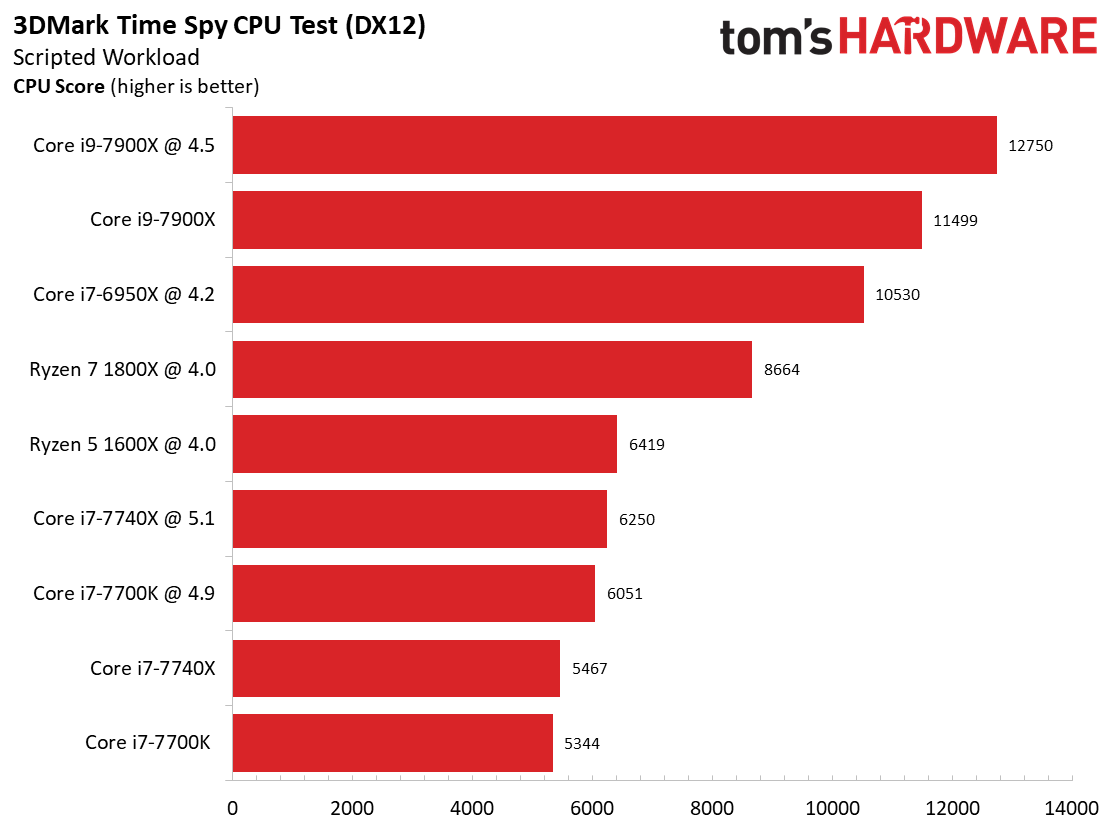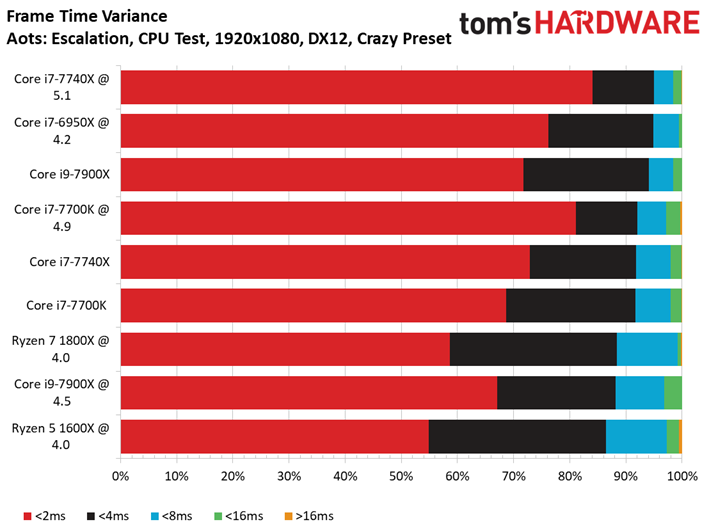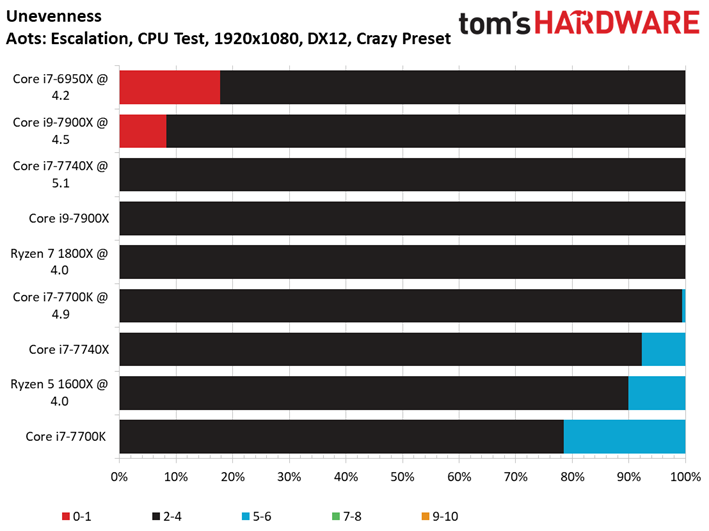Intel Core i7-7740X Kaby Lake-X Review
Why you can trust Tom's Hardware
VRMark, 3DMark & AotS: Escalation
Futuremark's VRMark test lets you gauge your system's suitability for use with the HTC Vive or Oculus Rift, even if you don't currently own an HMD. The Orange Room test is based on the suggested system requirements for current-generation HTC Vive and Oculus Rift HMDs. Futuremark defines a passing score as anything above 109 FPS.




As expected, we notice slight variation between the stock Core i7-7700K and its near-identical -7740X counterpart. Testing at each chip's default memory settings (DDR4-2400 for the -7700K and DDR4-2666 for the -7740X) likely contributes some of the difference. And we notice the same behavior with the stock and overclocked settings.
3DMark's DX11 and DX12 tests follow a similar pattern. The beefier multi-core CPUs leverage their extra threads to take commanding leads in these compute-intensive tests. But tuning brings the -7740X within striking range of the overclocked six-core Ryzen 5 1600X. Intel's Kaby Lake-X model enjoys a greater lead over the -7700K in the DX11 physics test, which we chalk up to an extra 200 MHz of overclocking headroom.
We encountered some strangeness during the 3DMark API overhead test. Core i7-7740X lags its -7700K sibling by a large margin during the DX12 and Vulkan sequences; overclocking does little to correct the disparity. We suspect that this is a 3DMark-specific issue, since most of our DX12-based gaming benchmarks don't concur with these results. The API test is relatively new and has received a few recent updates. It's possible that we see another patch to address this unexpected measurement.
Ashes of the Singularity: Escalation






Ashes of the Singularity: Escalation favors core count over other factors, so we observe the expected variance between 4C/8T Core i7 CPUs and the more well-endowed processors.
Core i7-7740X exhibits a minor gain compared to the -7700K at both stock and overclocked settings. Interestingly, we encounter less variability and frame time outliers with the -7740X than the -7700K, which could be a result of slightly more aggressive memory settings. The slight bump in overclocked frequency only equates to a 2.34% advantage, though.
MORE: Best CPUs
Get Tom's Hardware's best news and in-depth reviews, straight to your inbox.
MORE: Intel & AMD Processor Hierarchy
MORE: All CPUs Content
Current page: VRMark, 3DMark & AotS: Escalation
Prev Page Test Setup Next Page Civilization VI & Battlefield 1
Paul Alcorn is the Editor-in-Chief for Tom's Hardware US. He also writes news and reviews on CPUs, storage, and enterprise hardware.
-
AgentLozen I'm glad that the option for Kaby Lake is available on the x299 chipset. In practice it seems impractical. This article shows you have to pay a lot more for slightly higher overclocking potential.Reply
I'm curious what Intel's plans are for next year regarding their high end desktop chips. They've already used the Kaby Lake X name for this generation. Should we expect Kaby Lake X 8900X? -
Kaz_2_ Intel high power consumption is not great in thr long run. You want the best for your investmentReply -
TJ Hooker ReplyThe curve below shows clearly that waste heat isn't dissipated quickly enough. Just as we did in our AMD Ryzen and Intel Core i9 launch articles, we used a very thin copper plate to measure the heat spreader's temperatures as well.
Why aren't there any numbers/divisions on the horizontal axis? Also, you say you did the same thing for the Ryzen reviews but I didn't see a similar graph in those articles (might just be blind though).
-
the nerd 389 How does the thermal performance of this chip compare to the 7700k? Specifically, does the larger surface area of the heat spreader give you a meaningful increase in thermal conductivity between the die and the heatsink?Reply -
rantoc Dang intel seem to be doing yet another stupid move with X299 beside rushing it out the door making the AMD's pretty brand new architecture/platform appear mature in comparison. As for this move - What's the incentive to pay premium for the X299 when getting a chip like this that won't even utilize it fully? The 7700k and platform are equal in performance in most tests and far cheaper...Reply
With the poor thermal transfer between the core and heat-spreader the retail chips won't likely even overclock well either. Never cared about the cherry picked "reviews" chips at all when it comes to overclocking as they very rarely represent the retail chips. -
rantoc What's the incentive to buy an expensive motherboard and yet get near zero of it's true potential with this cpu? That's paying for a lot of real estate that can't be used at all and on top of that the same poor thermal transfer between the core and heat-spreader meaning a good stable oc is harder to obtain and far less likely to happen on the retail IE non-review cherry picked ones.Reply
I think intel shoot themselves in the foot by scaling this one down to much and then couple it with an overpriced platform for what you get out of it, x299 will be good no doubt but only with the right chips and only when the rushed out of door bugs been fixed. -
This is awesome setup because you can buy x299 motherboard for $219 dollars already which gives you amazing room for later upgrade and this CPU can run 5.0Ghz easily producing very little heat. People at Toms Hardware completely missed the point. I'd rather get $219 x299 motherboard than outdated Z270 for $160.Reply